Improved Aerodynamics of a Hollow-Blade Axial Flow Fan by Controlling the Leakage Flow Rate by Air Injection at the Rotating Shroud
Abstract
:1. Introduction
2. Experimental Setup
2.1. Blade Geometry
2.2. Test Bench and Drive System
2.3. Torque Measurement
3. CFD Modeling and Grid Generation
4. Results
4.1. Aeraulic Power
4.2. Resistant Torque
- for (1000 rpm, and independently of the diaphragm diameter).
- for (2000 rpm, mm and ).
- Sensitivity of the torque meter used ( 5 N·m). The measurement range seems important relative to the values that have been measured which are quite small. It is desirable to equip the experimental setup with a more suitable torque meter. In addition, the measurements are not direct due to the size constraint of the assembly. The possibility of positioning the torque meter upstream of the fan (inside the box) has been abandoned due to disturbances induced in the upstream suction flow. In the event that the assembly is carried out downstream of the fan, the torque meter must be equipped with a hollow shaft (to ensure the control of the main flow) with sealed couplings to remedy leaks in the injection flow.
- Difficulty in determining the elementary torques of assembly components (belt transmission, coupling, rotating joint, etc.). We considered the net torque approach (without and with fan) with the hypothesis that with or without control, the elementary torques remains invariable.
4.3. Leakage Flow
- For the speed of 2000 rpm and an injection rate of , a specific reduction of about of the leakage flow.
- For the rest of the curves relating to the cases checked, a reduction between and of the leakage rate is achieved. The maximum reduction is obtained for low rotation speed (1000 rpm) and high injection rate .
4.4. Entropy Analysis
5. Conclusions
Author Contributions
Funding
Data Availability Statement
Conflicts of Interest
Nomenclature
| Torque without control | |
| C | Torque with control |
| Net torque | |
| Power gain added by the control | |
| Injection rate m·s | |
| Maximum injection flow rate m·s | |
| Fan flow rate m·s | |
| P | Power delivered by the fan [W] |
| Power delivered by the fan for | |
| Hub radius [m] | |
| Tip radius [m] | |
| leakage flow gap rate without control | |
| leakage flow gap rate with control | |
| Pressure difference generated by the fan [Pa] | |
| Injection rate | |
| Diaphragm diameter [m] | |
| Relative position between the fan and the carter [m] | |
| Position of the injection holes on the casing [m] |
References
- Boudet, J.; Cahuzac, A.; Kausche, P.; Jacob, M.C. Zonal large eddy simulation of a fan tip-clearance flow, with evidence of vortex wandering. J. Turbomach. 2015, 137, 061001. [Google Scholar] [CrossRef]
- Li, H.; Su, X.; Yuan, X. Entropy analysis of the flat tip leakage flow with delayed detached eddy simulation. Entropy 2019, 21, 21. [Google Scholar] [CrossRef] [PubMed] [Green Version]
- Fischer, A.; König, J.; Czarske, J.; Rakenius, C.; Schmid, G.; Schiffer, H.P. Investigation of the tip leakage flow at turbine rotor blades with squealer cavity. Exp. Fluids 2013, 54, 1–15. [Google Scholar] [CrossRef]
- Pogorelov, A.; Meinke, M.; Schröder, W. Effects of tip-gap width on the flow field in an axial fan. Int. J. Heat Fluid Flow 2016, 61, 466–481. [Google Scholar] [CrossRef]
- You, D.; Wang, M.; Moin, P.; Mittal, R. Effects of tip-gap size on the tip-leakage flow in a turbomachinery cascade. Phys. Fluid 2006, 18, 105102. [Google Scholar] [CrossRef] [Green Version]
- Zhang, B.; Liu, B.; Han, C.; Zhao, H. Control and entropy analysis of tip leakage flow for compressor cascade under different clearance sizes with endwall suction. Entropy 2020, 22, 128. [Google Scholar] [CrossRef] [PubMed] [Green Version]
- Lee, S.W.; Kim, S.U.; Kim, K.H. Aerodynamic performance of winglets covering the tip gap inlet in a turbine cascade. Int. J. Heat Fluid Flow 2012, 34, 36–46. [Google Scholar] [CrossRef]
- Wallis, A.M.; Denton, J.D.; Demargne, A.A.J. The control of shroud leakage flows to reduce aerodynamic losses in a low aspect ratio, shrouded axial flow turbine. J. Turbomach. 2001, 123, 334–341. [Google Scholar] [CrossRef]
- Corsini, A.; Rispoli, F.; Sheard, A.G. Development of improved blade tip endplate concepts for low-noise operation in industrial fans. Proc. Inst. Mech. Eng. Part A 2007, 221, 669–681. [Google Scholar] [CrossRef]
- Aktürk, A.; Camci, C. Axial flow fan tip leakage flow control using tip platform extensions. J. Fluids Eng. 2010, 132, 51109. [Google Scholar] [CrossRef]
- Pardowitz, B.; Moreau, A.; Tapken, U.; Enghardt, L. Experimental identification of rotating instability of an axial fan with shrouded rotor. Proc. Inst. Mech. Eng. Part A 2015, 229, 520–528. [Google Scholar] [CrossRef]
- Longhouse, R.E. Control of tip-vortex noise of axial flow fans by rotating shrouds. J. Sound Vib. 1978, 58, 201–214. [Google Scholar] [CrossRef]
- Vad, J.; Horváth, C.; Kovács, J.G. Aerodynamic and aero-acoustic improvement of electric motor cooling equipment. Proc. Inst. Mech. Eng. Part A 2014, 228, 300–316. [Google Scholar] [CrossRef]
- Schramm, V.; Denecke, J.; Kim, S.; Wittig, S. Shape optimization of a labyrinth seal applying the simulated annealing method. Int. J. Rotating Mach. 2004, 10, 365–371. [Google Scholar] [CrossRef]
- Weigl, H.J.; Paduano, J.D.; Frechette, L.G.; Epstein, A.H.; Greitzer, E.M.; Bright, M.M.; Strazisar, A.J. Active stabilization of rotating stall and surge in a transonic single stage axial compressor. Am. Soc. Mech. Eng. 1997. [Google Scholar] [CrossRef] [Green Version]
- Rhee, S.H.; Kim, S.E.; Ahn, H.; Oh, J.; Kim, H. Analysis of a jet-controlled high-lift hydrofoil with a flap. Ocean Eng. 2003, 30, 2117–2136. [Google Scholar] [CrossRef]
- Eberlinc, M.; Širok, B.; Hočevar, M. Experimental investigation of the interaction of two flows on the axial fan hollow blades by flow visualization and hot-wire anemometry. Exp. Therm. Fluid Sci. 2009, 33, 929–937. [Google Scholar] [CrossRef]
- Eberlinc, M.; Širok, B.; Dular, M.; Hočevar, M. Modification of axial fan flow by trailing edge self-induced blowing. J. Fluids Eng. 2009, 131, 111104. [Google Scholar] [CrossRef]
- Eberlinc, M.; Širok, B.; Hočevar, M.; Dular, M. Numerical and experimental investigation of axial fan with trailing edge self-induced blowing. Forsch. Ingenieurwesen 2009, 73, 129. [Google Scholar] [CrossRef]
- Neuhaus, L.; Neise, W. Active control to improve the aerodynamic performance and reduce the tip clearance noise of axial turbomachines with steady air injection into the tip clearance gap. In Active Flow Control; Springer: Berlin/Heidelberg, Germany, 2007; pp. 293–306. [Google Scholar]
- Morris, S.C.; Foss, J.F. An aerodynamic shroud for automotive cooling fans. J. Fluids Eng. 2001, 123, 287–292. [Google Scholar] [CrossRef]
- Niu, M.; Zang, S. Experimental and numerical investigations of tip injection on tip clearance flow in an axial turbine cascade. Exp. Therm. Fluid Sci. 2011, 35, 1214–1222. [Google Scholar] [CrossRef]
- Buisson, M.; Ferr, P.; Soulat, L.; Aubert, S.; Moreau, S.; Rambeau, C.; Henner, M. Optimal design of an automotive fan using the Turb’Opty meta-model. Comput. Fluid 2013, 80, 207–213. [Google Scholar] [CrossRef]
- Azzam, T.; Paridaens, R.; Ravelet, F.; Khelladi, S.; Oualli, H.; Bakir, F. Experimental investigation of active control by steady air injection in the tip clearance gap of an axial fan. In Proceedings of the International Symposium on Transport Phenomena and Dynamics of Rotating Machinery, Honolulu, HI, USA, 10–15 April 2016. [Google Scholar]
- Azzam, T.; Paridaens, R.; Ravelet, F.; Khelladi, S.; Oualli, H.; Bakir, F. Experimental investigation of an actively controlled automotive cooling fan using steady air injection in the leakage gap. Proc. Inst. Mech. Eng. Part A 2017, 231, 59–67. [Google Scholar] [CrossRef] [Green Version]
- Sarraf, C.; Nouri, H.; Ravelet, F.; Bakir, F. Experimental study of blade thickness effects on the overall and local performances of a controlled vortex designed axial-flow fan. Exp. Therm. Fluid Sci. 2011, 35, 684–693. [Google Scholar] [CrossRef] [Green Version]
- Yoon, S.; Selmeier, R.; Cargill, P.; Wood, P. Effect of the stator hub configuration and stage design parameters on aerodynamic loss in axial compressors. J. Turbomach. 2015, 137, 91001. [Google Scholar] [CrossRef]
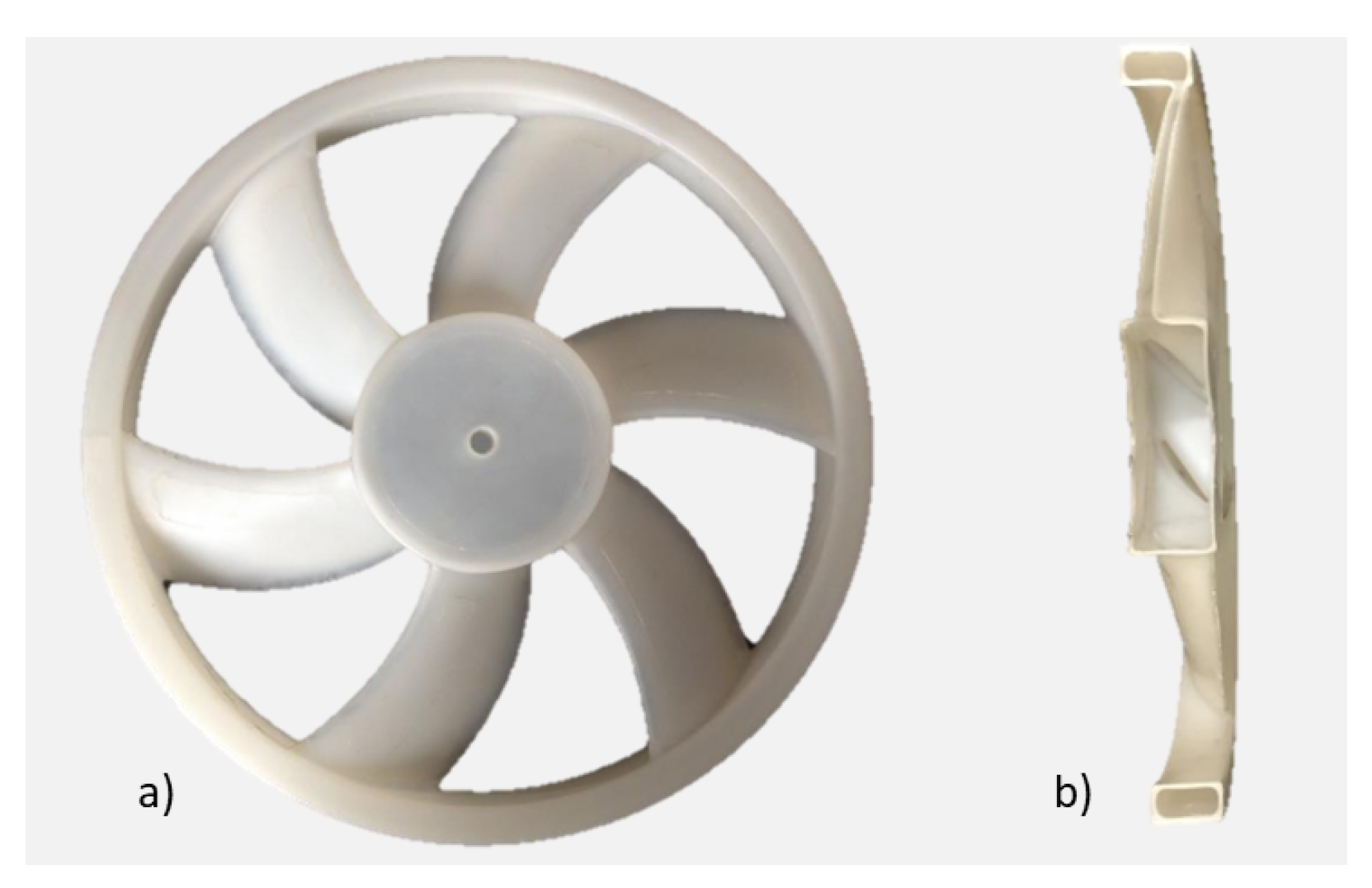

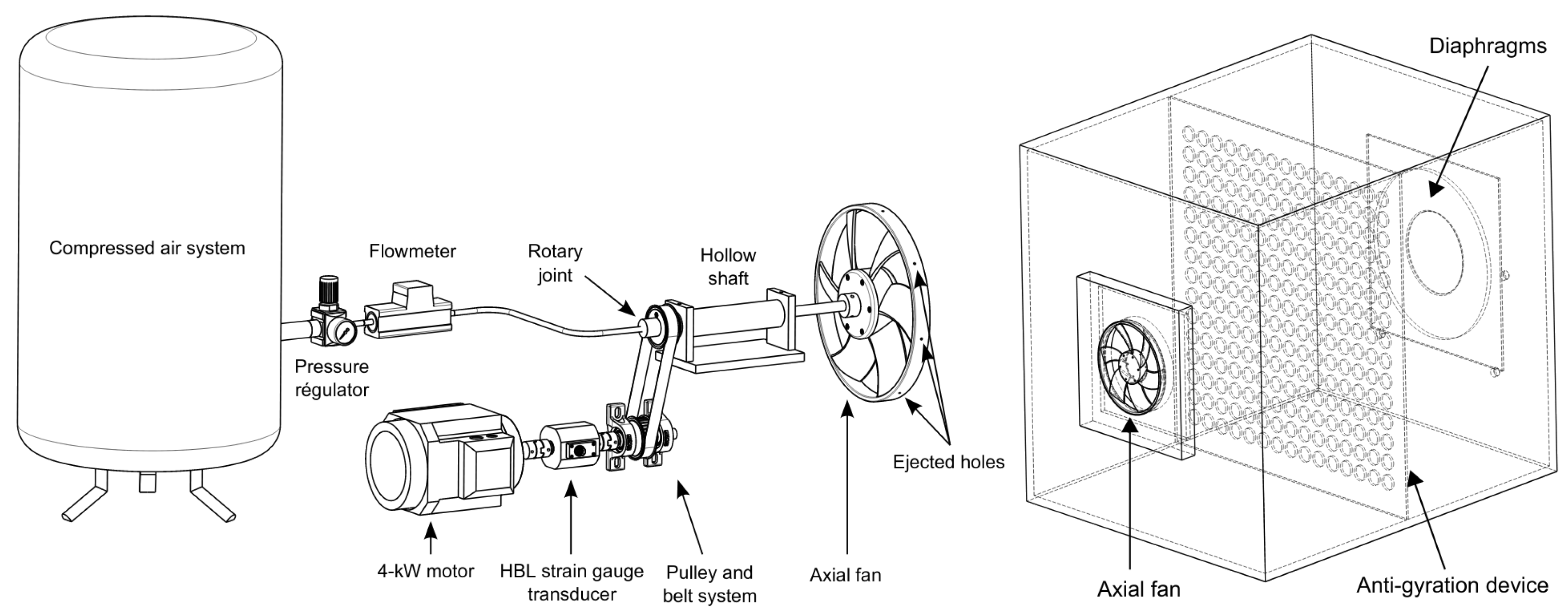


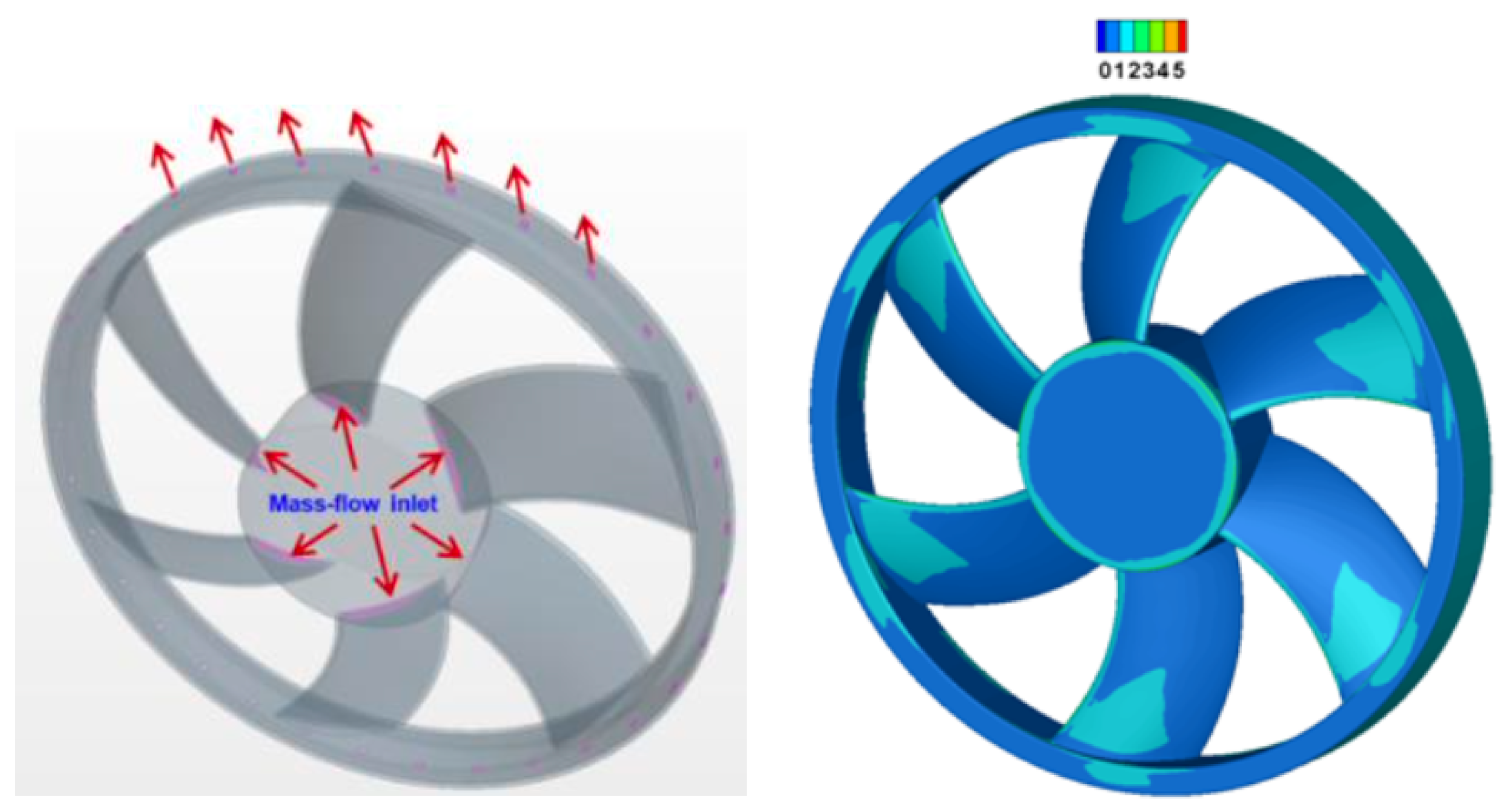
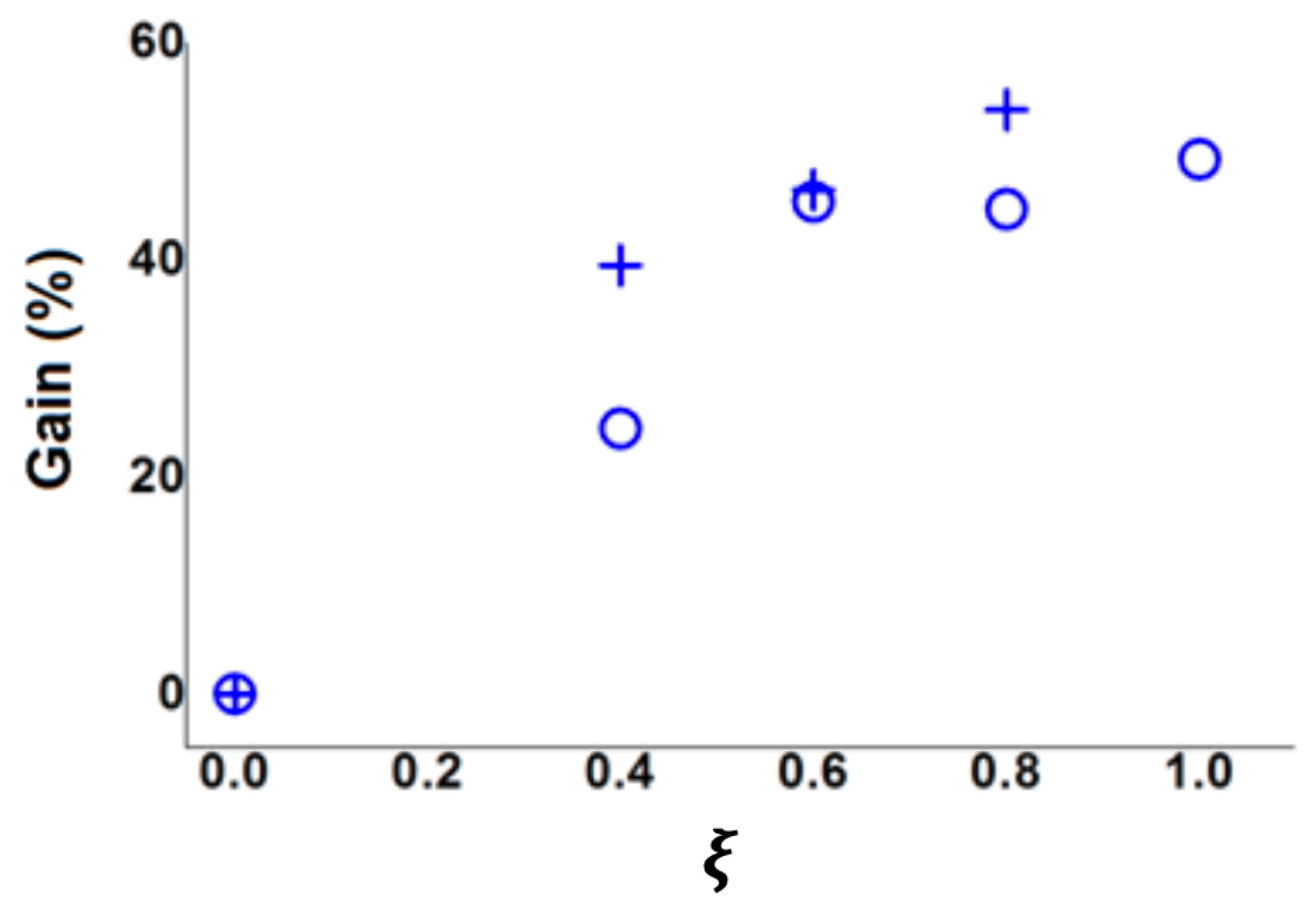
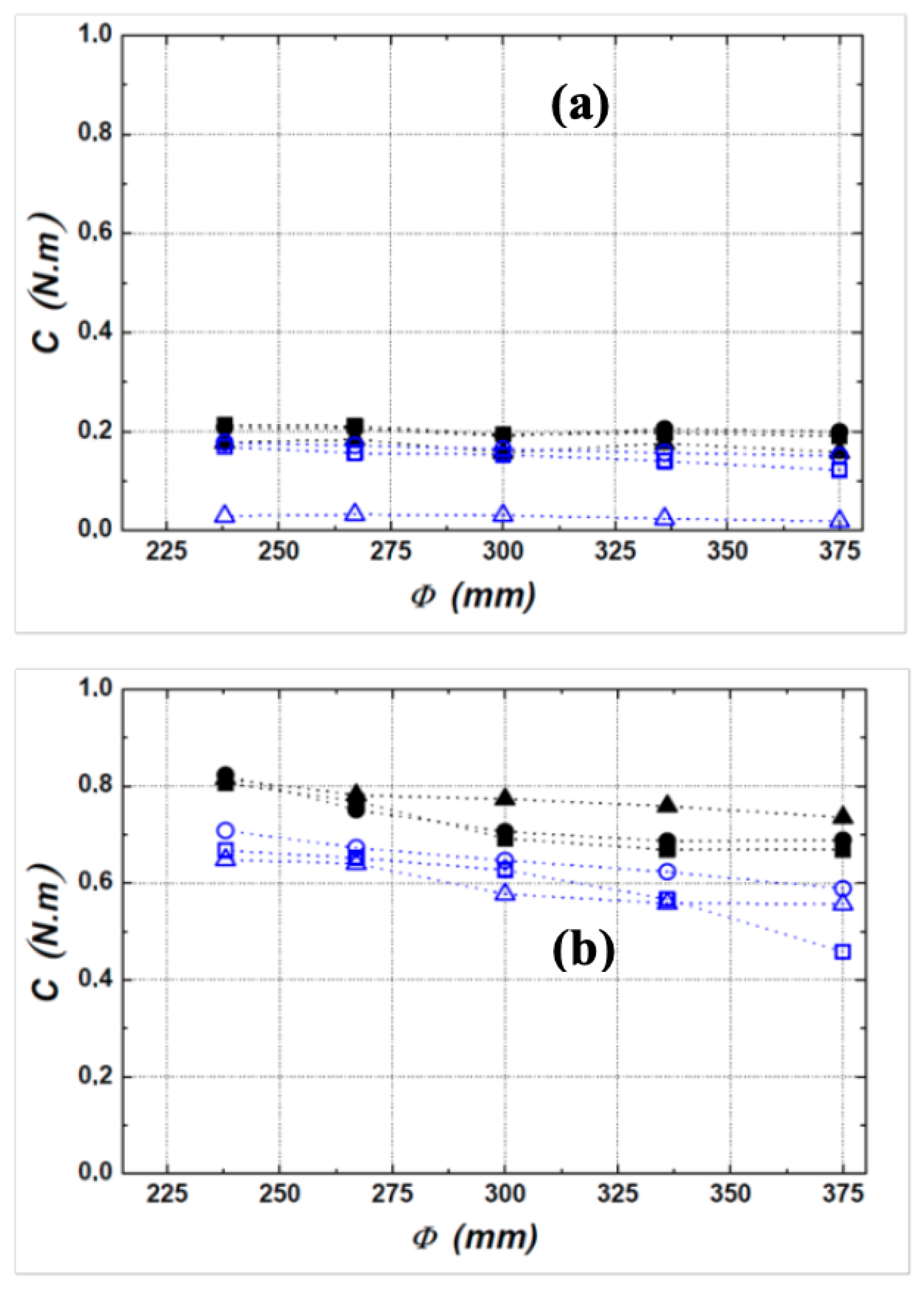





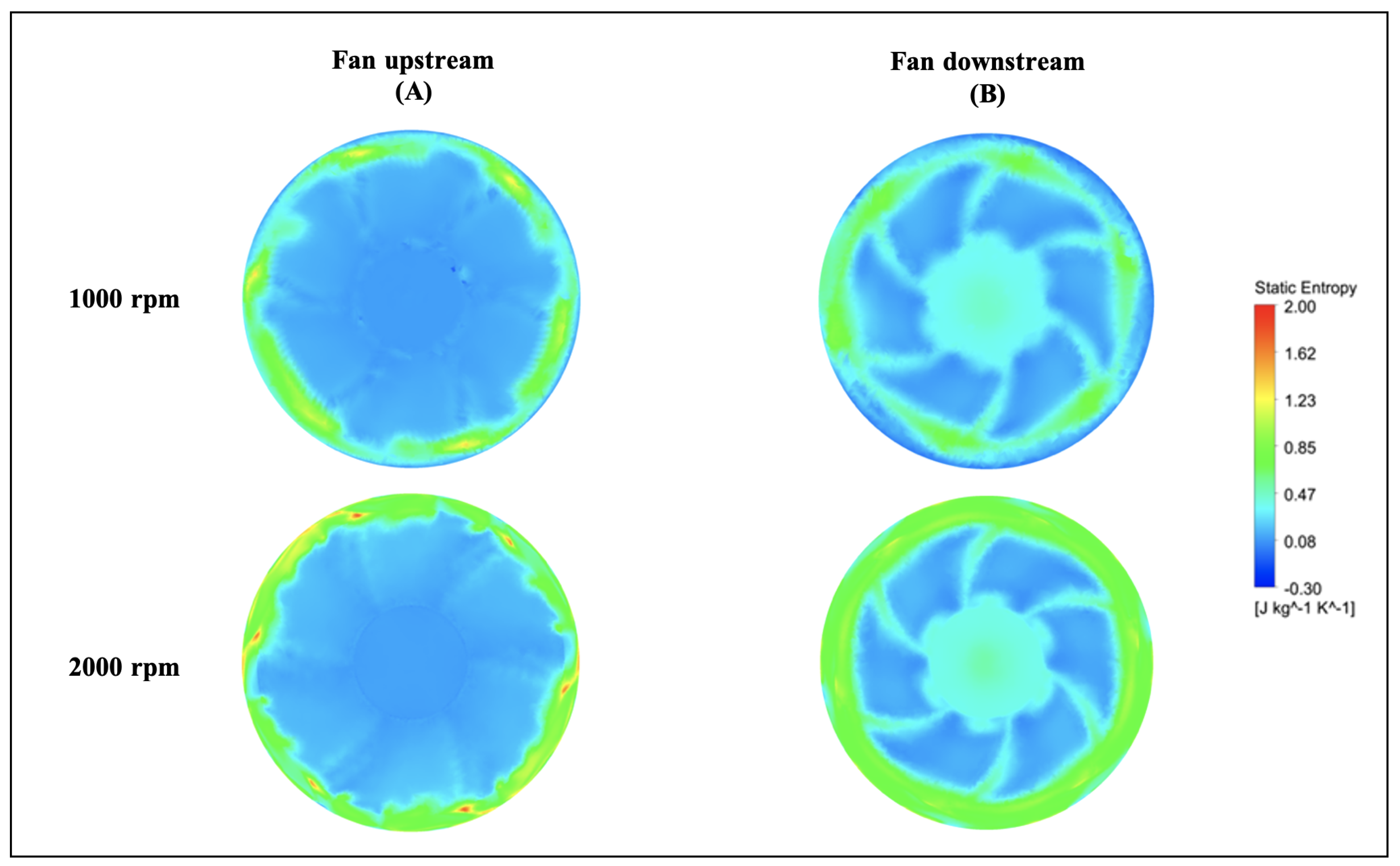

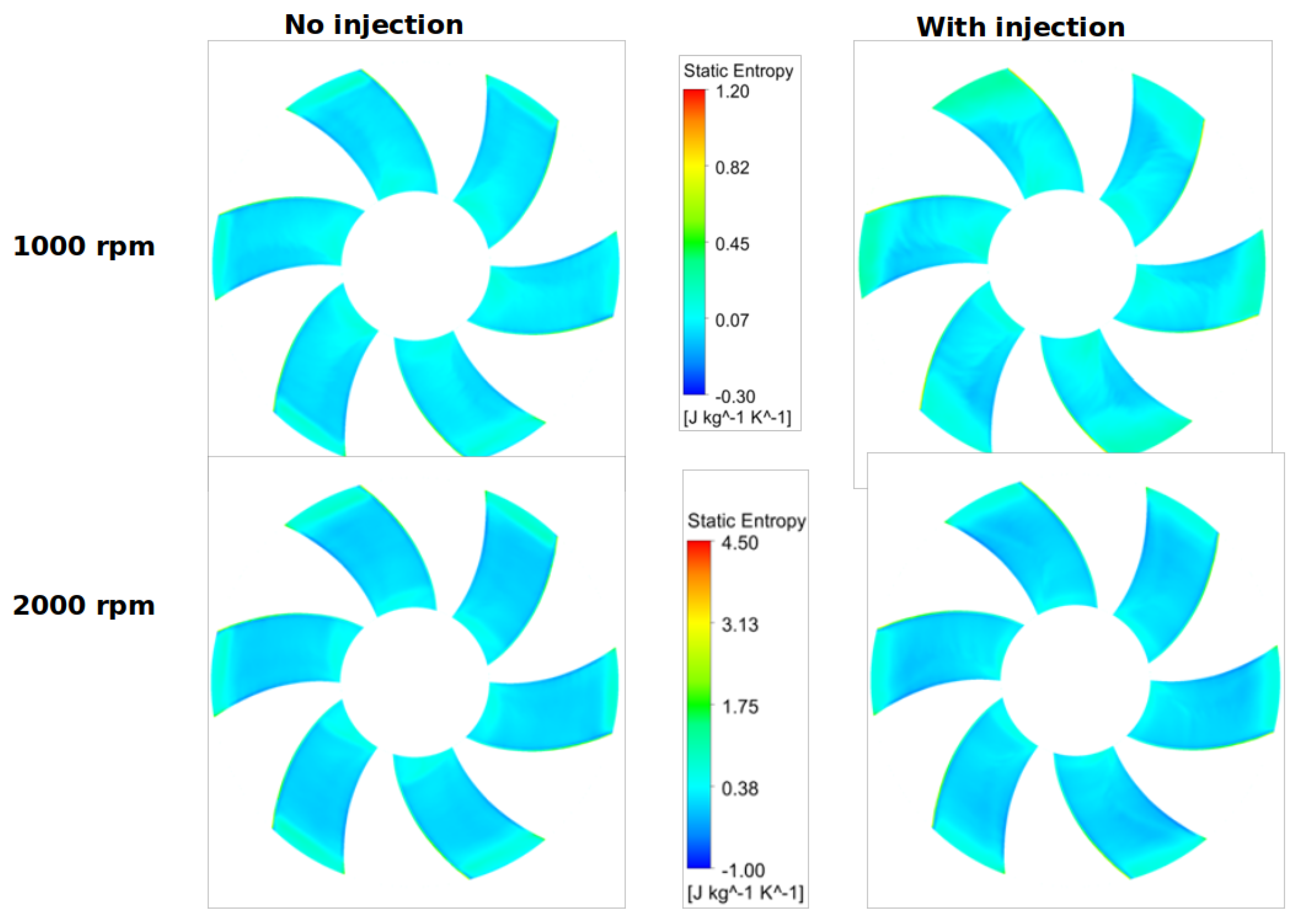

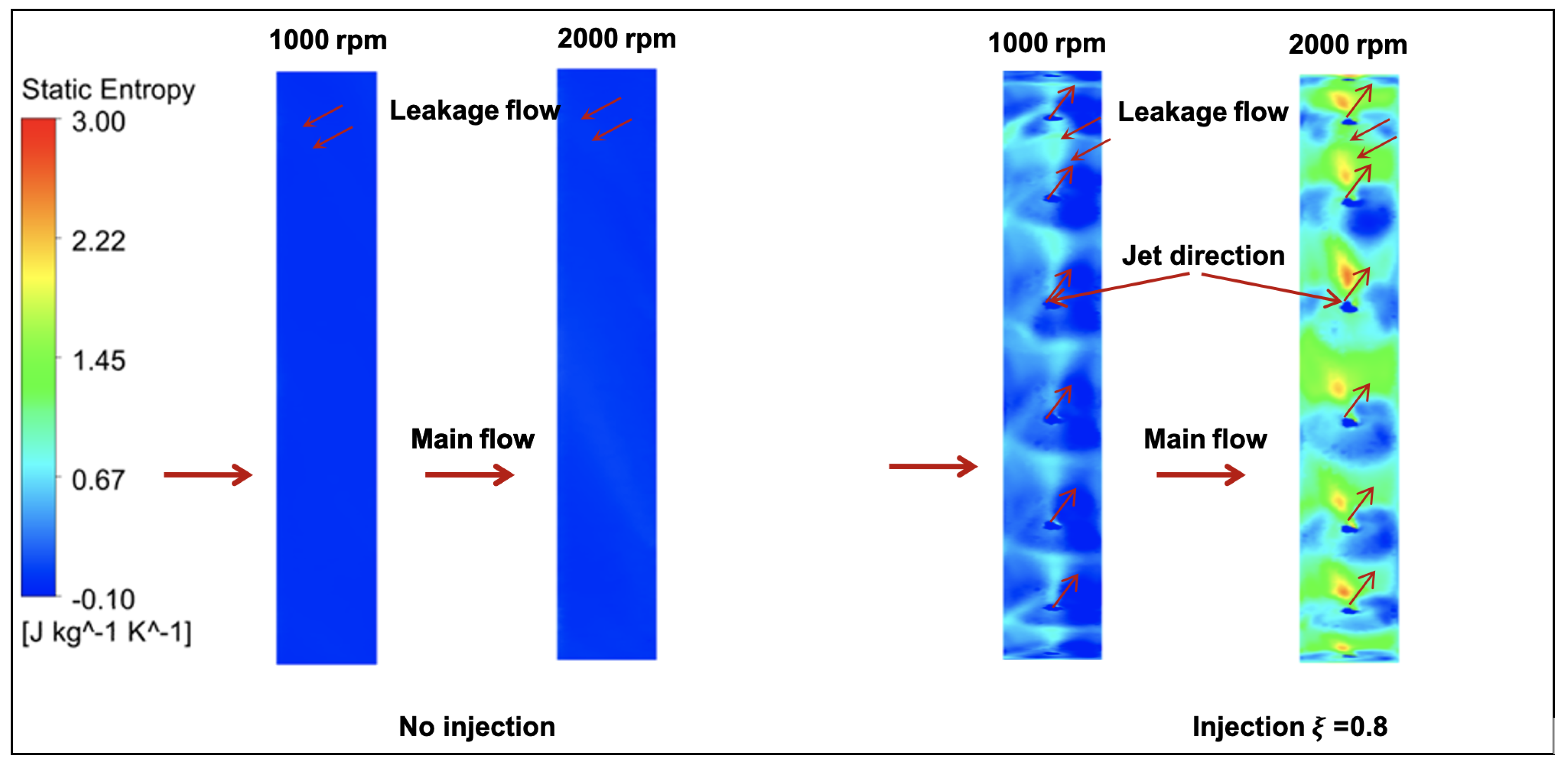
| (mm) | 77 | 151 | 169 | 190 | 220 | 238 | 267 | 300 | 336 | 375 |
| Grid | Rotating Domain | Fixed Domain | C | |||
|---|---|---|---|---|---|---|
| ( cells) | ( cells) | (Pa) | (m·s) | (N·m) | (kg·s) | |
| (1) | 0.130 | 0.731 | 64 | 0.459 | 0.399 | 0.0378 |
| (2) | 0.532 | 1.678 | 52 | 0.408 | 0.345 | 0.0378 |
| (3) | 1.548 | 3.462 | 55 | 0.412 | 0.357 | 0.0414 |
| (4) | 2.227 | 4.935 | 55 | 0.411 | 0.352 | 0.0408 |
| (5) | 8.205 | 6.298 | 55 | 0.409 | 0.353 | 0.0402 |
Publisher’s Note: MDPI stays neutral with regard to jurisdictional claims in published maps and institutional affiliations. |
© 2021 by the authors. Licensee MDPI, Basel, Switzerland. This article is an open access article distributed under the terms and conditions of the Creative Commons Attribution (CC BY) license (https://creativecommons.org/licenses/by/4.0/).
Share and Cite
Pereira, M.; Ravelet, F.; Azzouz, K.; Azzam, T.; Oualli, H.; Kouidri, S.; Bakir, F. Improved Aerodynamics of a Hollow-Blade Axial Flow Fan by Controlling the Leakage Flow Rate by Air Injection at the Rotating Shroud. Entropy 2021, 23, 877. https://doi.org/10.3390/e23070877
Pereira M, Ravelet F, Azzouz K, Azzam T, Oualli H, Kouidri S, Bakir F. Improved Aerodynamics of a Hollow-Blade Axial Flow Fan by Controlling the Leakage Flow Rate by Air Injection at the Rotating Shroud. Entropy. 2021; 23(7):877. https://doi.org/10.3390/e23070877
Chicago/Turabian StylePereira, Michaël, Florent Ravelet, Kamel Azzouz, Tarik Azzam, Hamid Oualli, Smaïne Kouidri, and Farid Bakir. 2021. "Improved Aerodynamics of a Hollow-Blade Axial Flow Fan by Controlling the Leakage Flow Rate by Air Injection at the Rotating Shroud" Entropy 23, no. 7: 877. https://doi.org/10.3390/e23070877
APA StylePereira, M., Ravelet, F., Azzouz, K., Azzam, T., Oualli, H., Kouidri, S., & Bakir, F. (2021). Improved Aerodynamics of a Hollow-Blade Axial Flow Fan by Controlling the Leakage Flow Rate by Air Injection at the Rotating Shroud. Entropy, 23(7), 877. https://doi.org/10.3390/e23070877








